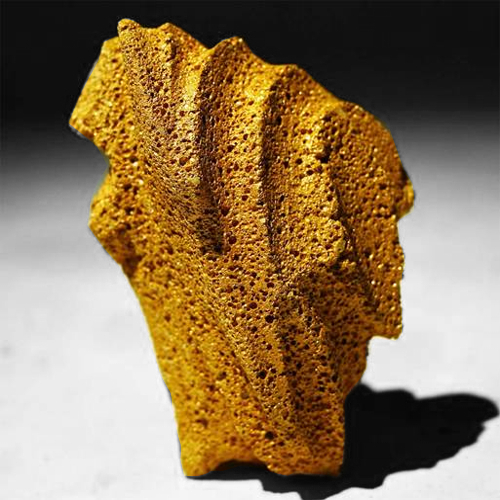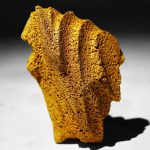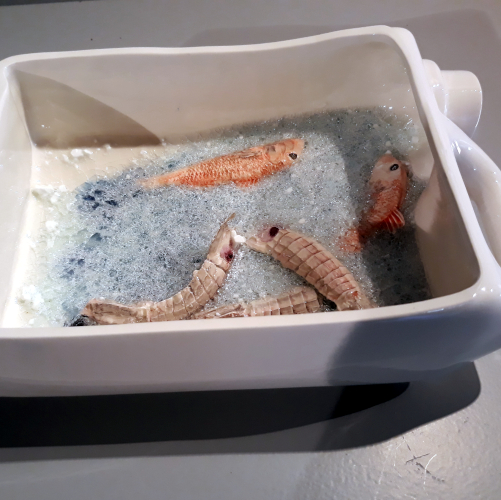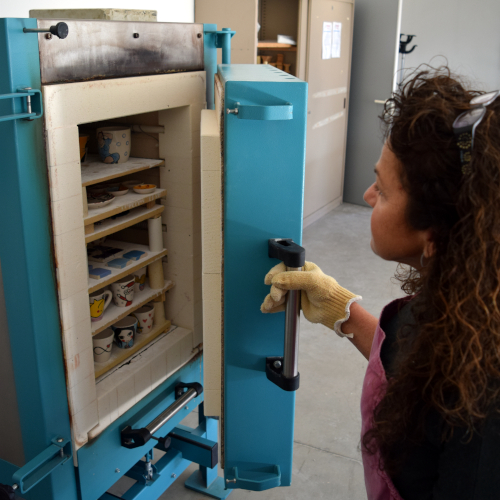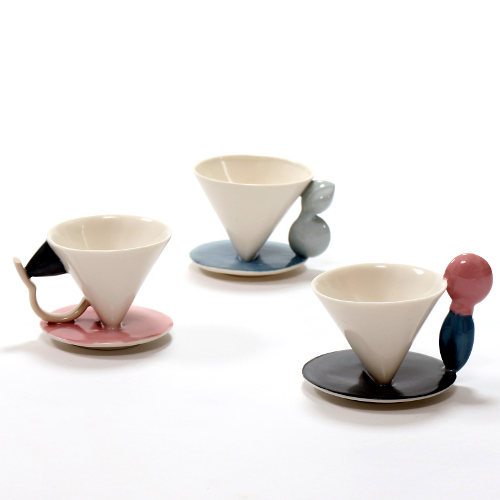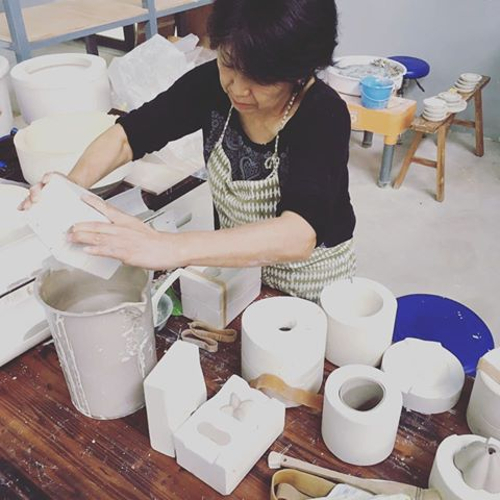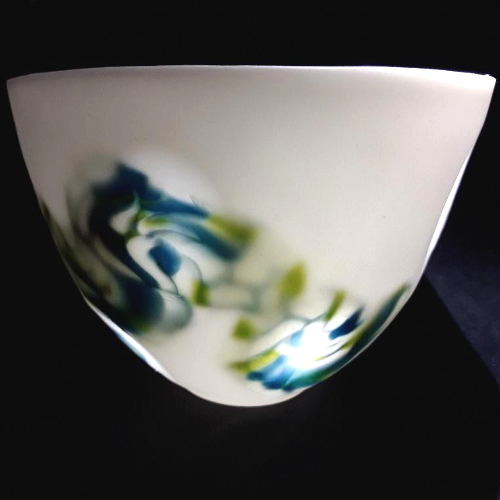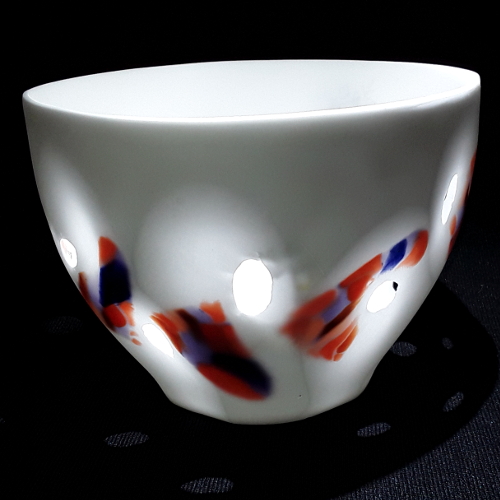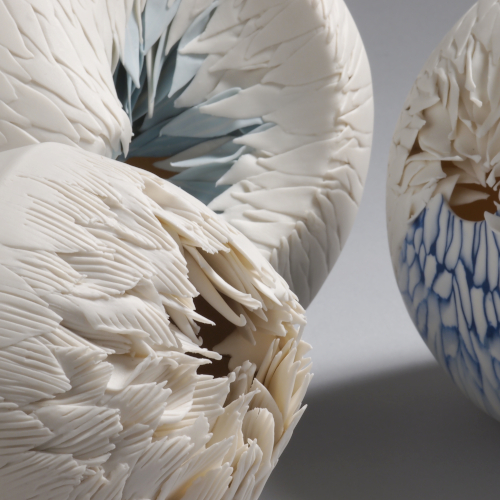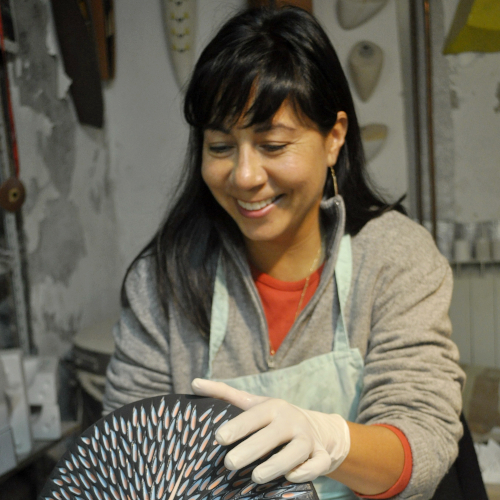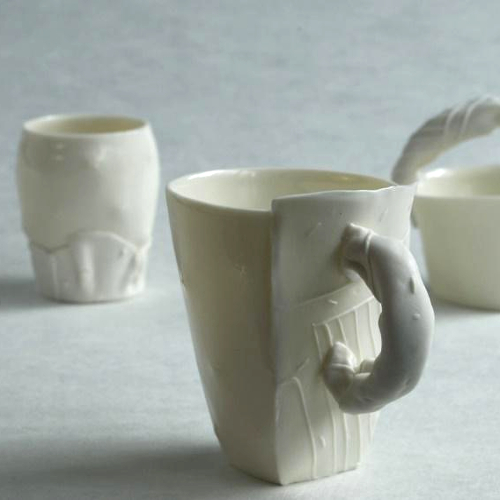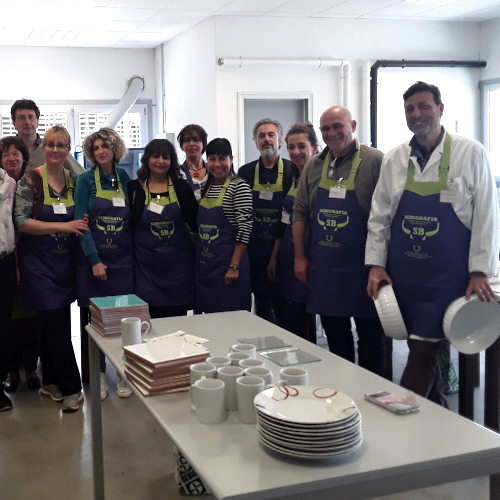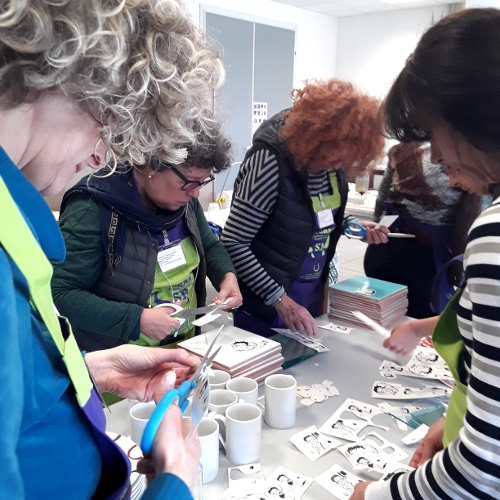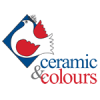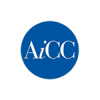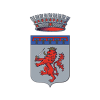Thousand bubbles
10 and 11 March 2018
Una delle premesse in campo ceramico, fondamento della didattica e della tecnologia stabilisce che non vi devono essere bolle di aria negli impasti ceramici ma…
E’ anche vero che la presenza di bolle e la stessa porosità delle argille favorisce l’isolamento termico, l’essiccazione e la leggerezza. Con impasti a struttura spugnosa si ottengono forme facilmente lavorabili a secco/crudo per mezzo del taglio, incisione o abrasione, una lavorabilità a biscotto simile a quella dell’osso di seppia, durezza inaspettata dopo la cottura finale e il peso vicino a quello dei poliuretani espansi.
Da questa scelta parte la possibilità di creare forme legate in particolare al campo della scultura dove i problemi dello svuotamento delle forme viene superato velocizzando le cotture. Infine e in relazione alla dimensione delle microbolle inserite sarà possibile anche l’applicazione di patine, ingobbi e rivestimenti anche vetrosi.
Programma: metodi di realizzazione di schiume e la loro introduzione nelle argille – colatura della schiuma argillosa – essiccamento – scultura a secco crudo per taglio/incisione – cottura ad alta temperatura in forno elettrico – sfornata – applicazione di rivestimento tipo smalto oro – cottura a media temperatura – lezioni di tecnologia ceramica. Per motivi di tempo e aumentare l’esperienza sulla tecnica saranno forniti ai partecipanti anche alcuni blocchetti di argilla porosa già essiccati.
Il corso di 14 ore dura dalle ore 9.00 alle ore 17:00 del sabato e dalle ore 9:00 alle ore 16.00 della domenica.
Docente: Maestro Giovanni Cimatti
Scarica il modulo di iscrizione in formato pdf
Scarica il volantino in formato pdf
Related products
Extraordinary japanese constructions with Kazuko Uga
10 and 11 October 2018
A complex and fascinating technique focused on the personal artistic work of Kazuko Uga. The construction of the liquid porcelain will allow us to develop contemporary projects of great beauty, refinement and lightness. Course of construction of objects with the use of white and pigmented liquid porcelain. Course of construction of objects with the use of slip porcelain and treatment of surfaces in the Japanese style. Preparation of porcelain, recipes. Drying, firing, glazing, corrections of cracks and deformations.
The artist will be on show in Faenza from the 9th to the 21st of October as part of the "Japanese October" Festival.
PROGRAM: Fully practical lessons with a theoretical chapter dedicated to the preparation of slip withe and coloured porcelain. First day: Preparation of liquid porcelain, precautions. Preparation of liquid coloured porcelain, recipes and percentages. Methods of slip casting porcelain. Construction with the small parts, finishing, drying. Firing, kiln management for high temperature. Second day: Finishing and cleaning pieces, tricks and corrections. Evaluation of results. Design of new pieces for both sculpture and use. Video-projection of the artist's works.The 14-hours workshop lasts from 9.00 to 17.00 on Wednesday and from 9.00 to 16.00 on Thursday.
Teacher: Kazuko Uga Translator and assistant: Martha Pachon Languages: English, Italian, French, Spanish, Japanese Download the Kazuko Uga CV Download the application form in pdf Download the full program in pdfJasper and Neriage
6, 7 and 8 April 2018
Two techniques distant in time and in geography, one technique, with slip porcelain and another with body porcelain, come together in a complex but fascinating technique with a wide variety of applications, from the unique piece to small series. To make the most of the potential of these techniques: Jasper and Nerikomi, the students will perform different exercises to get to know their fragility, strength and refinement. All the process and derivations for applications to different kind of objects, corrections of cracks, breakages and deformation.
Program: - Totally practical lessons with a theoretical chapter by technology. - Preparation of colored slip porcelain, recipe and percentages. - Preparation of colored body porcelain, recipe and percentages. - Creation of small pieces with different color combinations. - Methods of creating organic or geometric motifs. - Methods of including one technique on the other. - Surface finishing method. - Biscuit firing. - Finishing and corrections after biscuit firing. - Methods of positioning of the pieces into the kiln for high firing. Special features to avoid deformation and breakage. - Finishing and corrections after the last firing.The 20-hour workshop lasts from 9.00 to 17.00 on Friday and Saturday and from 9.00 to 16.00 on Sunday.
Teacher: Martha Pachon
Download the application form in pdf Download the program in pdf
DYNAMIC PORCELAIN | Martha Pachon
12-13-14 April 2019
Inspired by the new developments of contemporary ceramics, both utilitarian and decorative, sculptural or any application that can be made of this precious material, this course is structured as a laboratory of "multiprocesses" to know and master the basic techniques of slip and body porcelain. Understanding porcelain in a practical, direct, easy and fast way will be the goal of this course. Participants will have at their disposal different techniques, some simple and other complex, with and without the use of molds, with the possibility of glazing also in single firing, with theoretical chapter dedicated in detail to all the questions regarding porcelain: drying, breakage, deformation, firing curves, etc.
THE PARTICIPANTS, BEYOND TO BRING HIS FINISHED WORKS TO HOME, WILL HAVE THE RIGHT KNOWLEDGE OF ALL THE RESOURCES IN THE FIELD OF THE PORCELAIN: ITS QUALITY OF TRANSPARENCY, RESISTANCE, REFINEMENT AND WITHOUT GOING CRAZY!
The 20-hour workshop lasts from 9.00 to 17.00 on Friday and Saturday and from 9.00 to 16.00 on Sunday.
Included in the Workshop cost: 20 hours of teaching | all the necessary materials | firings | nr. 3 brunch lunch | a box with the samples of the materials used during the workshopTeacher: Martha Pachon Languages: English, Italian, French, Spanish
Download the full program in pdfTo confirm your inscription you have to make a bank transfer of a deposit or the total amount.
The sophistication of japanese slip porcelain with Kazuko Uga
12, 13 e 14 Ottobre 2018
DYNAMIC PORCELAIN | Martha Pachon
22-23-24 February 2019
Inspired by the new developments of contemporary ceramics, both utilitarian and decorative, sculptural or any application that can be made of this precious material, this course is structured as a laboratory of "multiprocesses" to know and master the basic techniques of slip and body porcelain. Understanding porcelain in a practical, direct, easy and fast way will be the goal of this course. Participants will have at their disposal different techniques, some simple and other complex, with and without the use of molds, with the possibility of glazing also in single firing, with theoretical chapter dedicated in detail to all the questions regarding porcelain: drying, breakage, deformation, firing curves, etc.
THE PARTICIPANTS, BEYOND TO BRING HIS FINISHED WORKS TO HOME, WILL HAVE THE RIGHT KNOWLEDGE OF ALL THE RESOURCES IN THE FIELD OF THE PORCELAIN: ITS QUALITY OF TRANSPARENCY, RESISTANCE, REFINEMENT AND WITHOUT GOING CRAZY!The 20-hour workshop lasts from 9.00 to 17.00 on Friday and Saturday and from 9.00 to 16.00 on Sunday.
Included in the Workshop cost: 20 hours of teaching | all the necessary materials | firings | nr. 3 brunch lunch | a box with the samples of the materials used during the workshopTeacher: Martha Pachon Languages: English, Italian, French, Spanish
Download the full program in pdf
To confirm your inscription you have to make a bank transfer of a deposit or the total amount.
Prehistoric firings
18 and 19 November 2017
Per chi ama i modi naturali e vede nella ceramica le varietà espressive che questi possono dare. Porterete tre forme essiccate (non cotte) di misura massima singola cm 20 (altezza) x 10 x 10 a spessore max mm7 realizzate in argille bianche da Raku. Le superfici delle forme potranno essere levigate a pressione ma non ingobbiate. Faremo esperienza di applicazione di argille su argille, di smalti in monocottura e di fiammature con cottura a legna che con la sua casualità ci mostrerà giochi infiniti di trasparenze, neri e lustri.
Programma: applicazione sulle vostre forme secche di ingobbi del genere Terra Sigillata, sali metallici, vernici e smalti – cottura notturna a biscotto – allestimento del fuoco e inserimento delle forme – cottura a legna – estrazione delle forme a mezza e fine cottura – lezioni di tecnologia a domanda.
Le forme saranno realizzate seguendo le indicazioni del docente, saranno cotte e consegnate entro i tempi del corso stesso. Il corso di 14 ore inizia alle ore 9.00 del sabato e termina alle ore 16.00 della domenica. Docente: Maestro Giovanni CimattiSilk-screen printing Workshop
12, 13 and 14 May 2017
Questo corso ha lo scopo di fornire le conoscenze necessarie per creare le proprie decalcomanie vetrificabili e stamparle su diversi supporti ceramici o vetrosi. Inoltre attraverso la stampa grafica su ceramica, il corsista sarà introdotto a un campo poco esplorato, il vincolo dell’immagine ceramica con la lettura virtuale incorporando i codici QR. Questi codici offrono l’opportunità di reindirizzare la ceramica sul concetto di un progetto web (un blog, una pagina, una libreria virtuale, un videogioco, ecc.)Il corsista sarà introdotto nella pratica della elaborazione di una matrice, l’incisione in seta, la pulizia e il recupero dei telai, l’applicazione delle decalcomanie, l’uso di diversi supporti, la preparazione degli smalti e delle cotture. Sarà inoltre in grado di installare il proprio laboratorio di serigrafia con i più bassi costi possibili di attrezzature e risparmio dello spazio.
BIOGRAFIA SILVIA BARRIOSArtista e ricercatrice nata in Argentina. Si è specializzata nel campo dei nuovi media e delle tecnologie interattive applicate sulle arti del fuoco.Il suo tema di interesse attuale la “Ceramica Intelligente” deriva degli incontri fra la Serigrafia Ceramica e i processi creativi dei multimedia incentrati sulla bio-arte, l’elettronica, l’intelligenza artificiale e le arti digitali unitamente alle culture popolari sudamericane.Silvia Barrios è stata invitata con i suoi laboratori e istallazioni alla Biennale della Havana, la Biennale di SaoPaulo, e la Biennale di Mercosur, Buenos Aires. Ha realizzato diversi progetti internazionali, e ha esposto indiversi nazioni, fra loro, Cina, Italia, Spagna, Portogallo, Cuba, Argentina, Colombia, Ecuador e Perù.
Programma: Lezioni pratiche e teoriche finalizzate allo sviluppo della impressione di una immagine fotografica su un sopporto ceramico terroso o vitreo, crudo, biscottato o smaltato e anche sul vetro. Elaborazione della matrice, trattamento della seta per l’incisione. Pulizia e recupero dei telai. Applicazione delle decalcomanie. Uso dei diversi supporti: terracotta, terraglia, gres, porcellana, vetro. Preparazione degli smalti per serigrafia. Cotture a diversi ambienti. Come istallare il proprio laboratorio di serigrafia. Introduzione del codice QR alla serigrafia. Conferenza audiovisiva – Riassunto del processo per consolidare le conoscenze – Test e valutazione dei risultati Riflessioni sulla introduzione dei codici multi mediatici e la progettazione sul campo della ceramica contemporanea – Panorama dei progetti innovatori della ceramica nel campo della elettronica, intelligenza artificiale, bioscienza e robotica. Conclusioni con una mostra di un progetto artistico di gruppo dei corsisti.
Le forme saranno realizzate seguendo le indicazioni del docente, saranno cotte e consegnate entro i tempi del corso stesso. Il corso di 20 ore dura dalle ore 9.00 alle ore 17:00 del venerdì, dalle 9.00 alle ore 17:00 del sabato e dalle ore 9:00 alle ore 16.00 della domenica. Docente: Silvia BarriosFull immersion in color
03 and 04 September 2018
From Jasper to Nerikomi in porcelain in two days
One of the finest qualities of porcelain is its sensuality to the touch, plus the surface can be enriched with vibrant colors or sharp contrasts of black and white. There are ancient and complex techniques of the "Neriage"family which, in a modern way, allow you to express yourself through many aesthetic solutions, from a jewel, avessel, a sculpture, an object, or a complex installation. It will be the very intense and rich post-Argillà course,among the techniques dealt with: the Jasper, the Rainbow or Scala, the Zebra, the Nerikomi and the Mosaico with composite tiles.
PROGRAMMA: - Preparation of colored porcelain bodies, recipes and percentages and how to avoid the melting or deforming pieces. - Use of color both into the body and slip porcelain, tricks. - Preparation of shapes, cuts, joints, lines, drawings and compositions for all possible ancient Asian techniques revisited in contemporary way with modern and practical use. - Agate, Jasper, Mishima, Mosaic, Rainbow, Scala, Zebra and Nerikomi techniques. - Cleaning and tricks to avoid color contamination, air bubbles, deformations or cracks. - Preparation of colored slip porcelain and use. - Conformations with net black and white avoiding contaminations of one color with another. - With the use of the mold and without, application of the techniques learned. - How to install the colored pieces inside the kiln avoiding the attachment of the pieces or accidents. - Types of firing, low and high, firing curves for pieces built by colored mix techniques. - Finishes and corrections before firing, after first firing and even after the last high temperature firing. - Recipes and possibility of restoration of broken pieces. Teacher: Martha Pachon Languages: English, Italian, French, Spanish Download the application form in pdf Download the program in pdf
